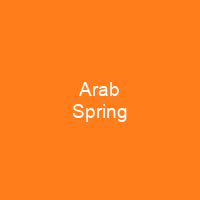Arab Spring

The Arab Spring was a series of anti-government protests, uprisings, and armed rebellions that spread across much of the Arab world in the early 2010s. Large-scale conflicts resulted: the Syrian Civil War; the rise of ISIL, insurgency in Iraq and the following civil war; the Egyptian Crisis, coup, and subsequent unrest and insurgency. Some have referred to the succeeding and still ongoing conflicts as the Arab Winter.
About Arab Spring in brief
 The Arab Spring was a series of anti-government protests, uprisings, and armed rebellions that spread across much of the Arab world in the early 2010s. It began in response to oppressive regimes and a low standard of living, starting with protests in Tunisia. Large-scale conflicts resulted: the Syrian Civil War; the rise of ISIL, insurgency in Iraq and the following civil war; the Egyptian Crisis, coup, and subsequent unrest and insurgency. Some have referred to the succeeding and still ongoing conflicts as the Arab Winter. As of May 2018, only the uprising in Tunisia has resulted in a transition to constitutional democratic governance. The term Arab Spring is an allusion to the Revolutions of 1848, which are sometimes referred to as the \”Springtime of Nations\”, and the Prague Spring in 1968. In the aftermath of the Iraq War, the term was used by various commentators and bloggers who anticipated a major Arab movement towards democratization. The use of the term ‘Arab Spring’ may have started with the US political journal Foreign Policy. I may have unintentionally coined the term in a January 2011 article for Foreign Policy magazine. Some observers have drawn comparisons between the Arab Spring and the Islamist Winter, which swept through Eastern Europe and the Second World War. When Arab Spring protests in some countries were followed by electoral success for Islamist parties, some American pundits coined the terms ‘Islamist Winter’ and ‘Muslim Spring’ to refer to the success of Islamist parties in the Middle East in the 1990s and early 2000s. In 2020, multiple conflicts are still continuing that might be seen as a result of theArab Spring.
The Arab Spring was a series of anti-government protests, uprisings, and armed rebellions that spread across much of the Arab world in the early 2010s. It began in response to oppressive regimes and a low standard of living, starting with protests in Tunisia. Large-scale conflicts resulted: the Syrian Civil War; the rise of ISIL, insurgency in Iraq and the following civil war; the Egyptian Crisis, coup, and subsequent unrest and insurgency. Some have referred to the succeeding and still ongoing conflicts as the Arab Winter. As of May 2018, only the uprising in Tunisia has resulted in a transition to constitutional democratic governance. The term Arab Spring is an allusion to the Revolutions of 1848, which are sometimes referred to as the \”Springtime of Nations\”, and the Prague Spring in 1968. In the aftermath of the Iraq War, the term was used by various commentators and bloggers who anticipated a major Arab movement towards democratization. The use of the term ‘Arab Spring’ may have started with the US political journal Foreign Policy. I may have unintentionally coined the term in a January 2011 article for Foreign Policy magazine. Some observers have drawn comparisons between the Arab Spring and the Islamist Winter, which swept through Eastern Europe and the Second World War. When Arab Spring protests in some countries were followed by electoral success for Islamist parties, some American pundits coined the terms ‘Islamist Winter’ and ‘Muslim Spring’ to refer to the success of Islamist parties in the Middle East in the 1990s and early 2000s. In 2020, multiple conflicts are still continuing that might be seen as a result of theArab Spring.
In 2019, multiple uprising and protest movements in Algeria, Sudan, Iraq, Lebanon, and Egypt have been seen by some as a continuation of Arab Spring. The early hopes that these popular movements would end corruption, increase political participation, and bring about greater economic equity quickly collapsed in the wake of the counter-revolutionary moves by foreign state actors in Yemen, the regional and international military interventions in Bahrain and Yemen, and the destructive civil wars in Syria, Iraq,. Libya, and Yemen. In Libya, a major civil war is ongoing, with Western powers and Russia sending in proxy fighters. In Lebanon, major banking crisis is threatening the economy of Lebanon as well as that of neighboring Syria. In Yemen, a civil war continues to affect the country. The Arab Spring has not faded and political movements against authoritarianism and exploitation are still occurring. In many countries, governments shut down certain sites or blocked Internet service entirely, especially in the times preceding a major rally. Governments also accused content creators of unrelated crimes or shutting down communication on specific sites or groups, such as Facebook. A major slogan of the demonstrators is ash-shaʻb yurīd isqāṭ an-niẓām. The importance of external factors versus internal factors to the protests’ spread and success is contested. The wave of initial revolutions and protests faded by mid-2012, as many Arab Spring demonstrations met with violent responses from authorities.
You want to know more about Arab Spring?
This page is based on the article Arab Spring published in Wikipedia (as of Dec. 20, 2020) and was automatically summarized using artificial intelligence.












